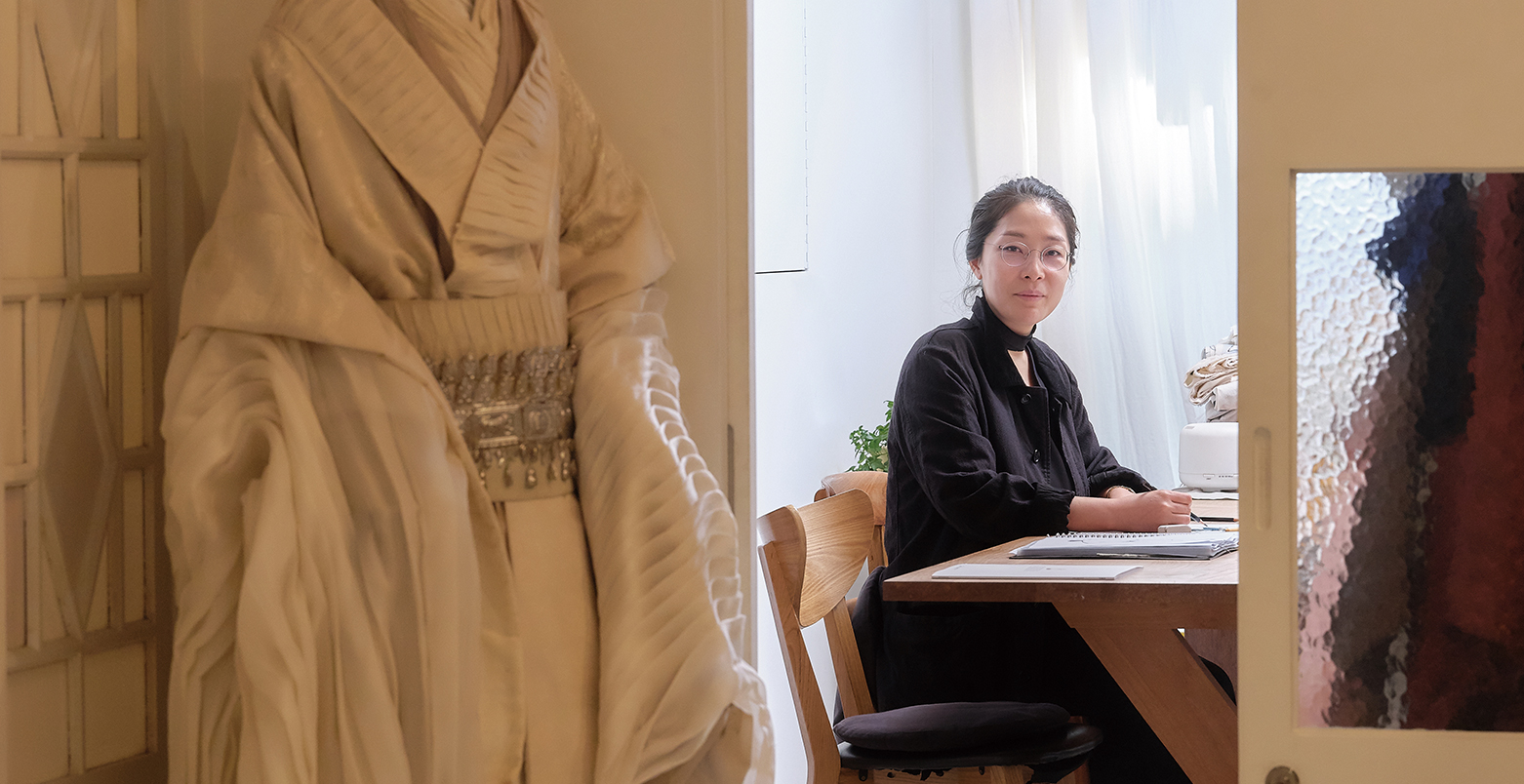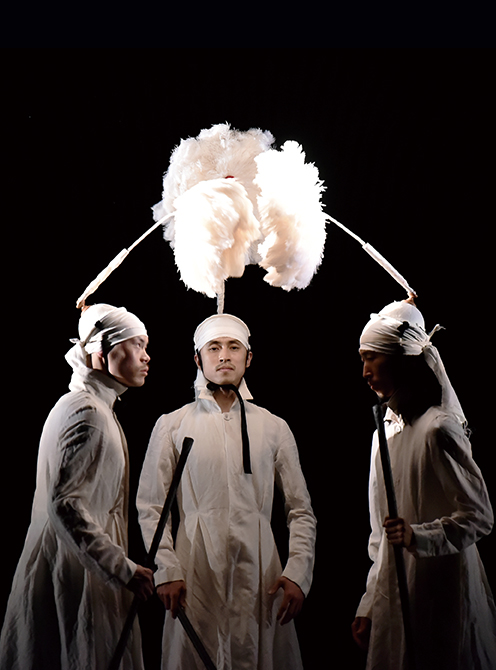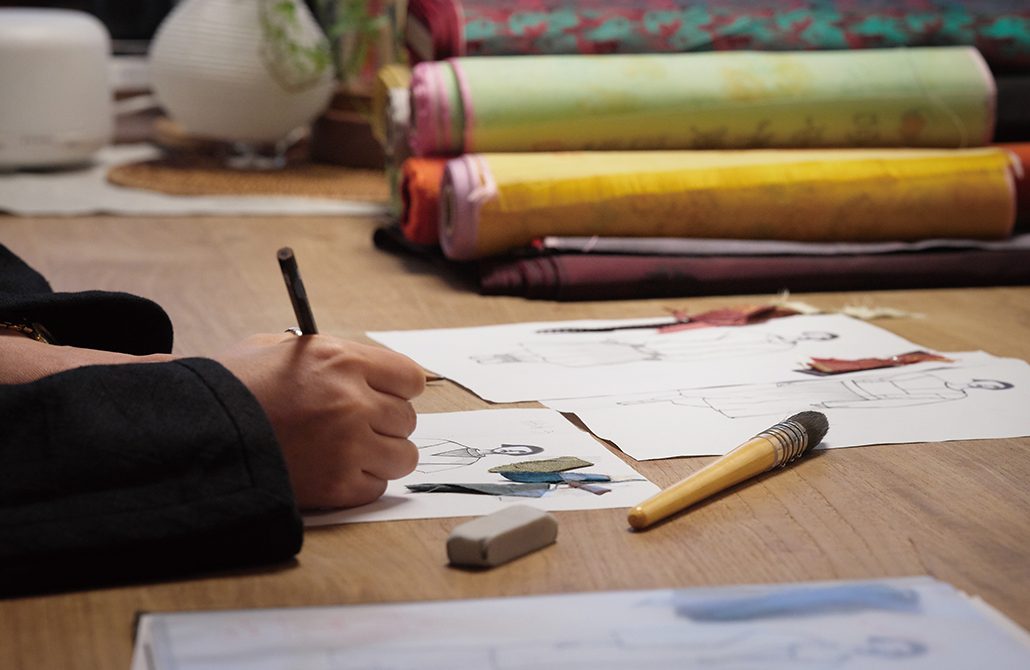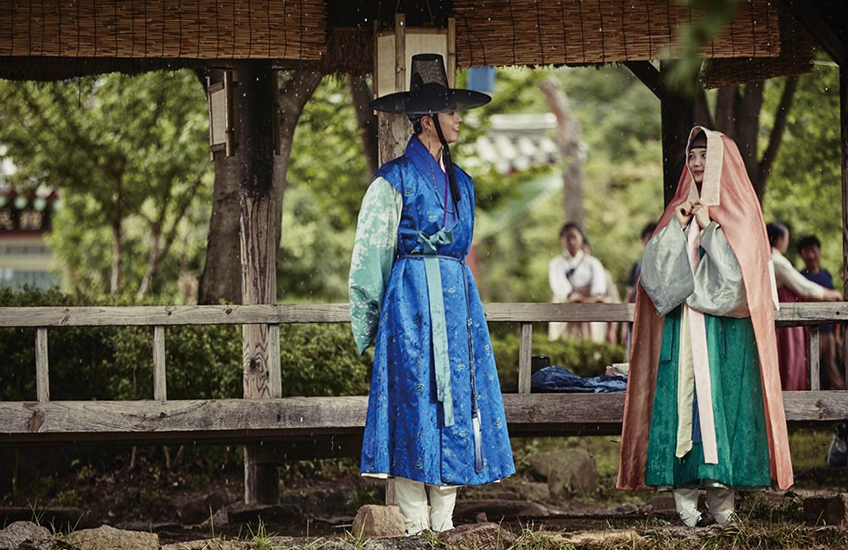
Contents










People · Written by Kim Samuel Photographed by Studio Kenn
Hanbok Designer Extraordinaire
Creating the New from the Old
The Korean dramas “Sungkyunkwan Scandal” and “Love in the Moonlight” not only popularized the distinct
beauty of hanbok (traditional Korean costumes) but also shined the spotlight on costume designer Lee Jin-hee.
The designs she created are praised for maintaining traditional character and
original shapes while adding contemporary colors and unique textures.
She has breathed life into characters in numerous works through her clothing creations.


Lee Jin-hee used to paint in high school and majored in stage design at Korea National University of Arts. Creating a theatrical piece with others, she said, was different from what she had imagined and made her feel lost. After accidentally dropping in on a puppet show class taught by a professor who had studied in France, Lee immediately took a leave of absence from school and started searching for theater companies in Korea that made puppets. At the time, all puppets in the country were either made of sticks or operated with fingers, which was not what she was looking for.
Lee then sought to attend the most renowned marionette school in France and apply for a homestay with an old puppet-making couple. Her family objected to this plan, so she bought a plane ticket and started working part time. She was then in a huge accident on her way back from work. “As my body began to recover after surgery, I was so bored. So my friends brought me novels to read and among them, I read the novel “Rose.” The life of a fashion designer depicted in the book was so appealing that I decided to learn about the profession. Since puppets need clothes anyway, I thought it would be useful.”
Walking on crutches, she sneaked out of the hospital to attend a fashion academy near the hospital for several months. She wanted to learn more than what was offered, however, so she lied that she was not a university student and got a job at a clothing manufacturer not far from where she lived. All of these twists and turns seemed to be like plot devices driving a drama that guided her to a career in clothing.

Lee Jin-hee not only designs traditional Korean clothing but also masks, belts and traditional Korean socks.
Commitment to Textiles
At the clothing company, Lee showed a strong passion to learn, and this persuaded her coworkers to teach her many skills and knowledge. She returned to school after a long period of feeling lost but with a stronger focus on clothing. “Senior staff at the company who were also going to school slowly began to assign me one small task after another, and I performed well. This led to more requests coming my way,” she said. “As what I imagined in my head could be made right away with needlework, I grew more interested in clothing than stage design, which was my primary major. During a trip to the Czech Republic, I found at a war museum a military outfit with traces of bullets. As I was gazing at it, I could feel space-time simultaneously, and I thought that I should focus on clothes rather than being fixated on just building sets for stages.”
Lee’s commitment to clothing took on higher meaning after the sudden death of her mother. While organizing her mother’s items, Lee saw something familiar: a maternity dress. “A family photo hung on a wall at the house of one of my mother’s relatives showed my mother, pregnant with me, holding my brother’s hand. My mother in the photo was about as old as I was (at the time of seeing the picture),” she said. “Like that, I encountered my mom in her 20s thinking that she must’ve had her own years of dreaming, worrying and evolving as a woman. I burned all of her things, but I couldn’t bring myself to burn that dress. I came to believe that clothes not only hold a person’s body shape and odor but also their memories.”
 Performance outfits of Truss Dance Company made by Lee Jin-hee show traditional Korean elements. © Lee Jin-hee
Performance outfits of Truss Dance Company made by Lee Jin-hee show traditional Korean elements. © Lee Jin-hee An idea is expressed in a drawing and transformed into a costume by hand.
An idea is expressed in a drawing and transformed into a costume by hand.Disregarding Age and Borders
Twenty years of making clothes has provided Lee with an exciting journey spanning generations and borders. She has traveled abroad and studied various eras to research the origins of characters’ stories. Among the films she has worked on, she considers the most “global” the 2018 Korean epic “The Great Battle.” Due to lack of historical records in South Korea, she had to look through North Korean and Chinese materials, and it was impossible to look at surviving murals and know what costumes people wore at the time except aristocrats. “We had to add some imagination to history. Because cultural exchanges with other nations were abundant at the time of the film, we expanded the range of references to West Asia,” she said. “To realize the rough and coarse feel of the clothes, we visited several countries to find fabric woven by hand or loom. We thus designed and obtained the materials and produced thousands of clothes, underwear and even socks for over a year.”
The historical drama “Love in the Moonlight” shot Lee to fame thanks to the new breed of hanbok she designed for the series. Instead of using diverse and vivid classic colors, she opted for modern pantone colors or color combinations borrowed from European classical paintings. “Costumes don’t stop at historical research but are rather by-products of creation that breathes life into characters,” she said.
Early in her career, Lee worked on the Korean production of the Shakespearean play “Hamlet,” a valuable work displaying her thoughts and efforts to dress characters regardless of age, gender or nationality. “We had to dress the clowns but because of no background, we couldn’t do anything at first. But that led me to focus solely on the characters. I tried to find out who they were, perhaps a modern-day laborer or a medieval shepherd? By guessing their professions according to their personalities, I took symbols from many eras, which ultimately enabled me to stylize a new world that belongs nowhere.”

The TV drama “Love in the Moonlight” featured characters wearing new styles of hanbok. © Lee Jin-hee
Searching for Essence
Based on her experiences and her philosophy formed through a long career, Lee has created unique clothing that cannot be categorized. HAMU, her own brand, showcases new hanbok designs that appeal to the public instead of traditional versions. Her designs have no gender division, fixed sizes or extravagant ornaments. “If clothing gets too fancy, the wearer is not revealed. When I made hanbok for the first time while preparing for a play, I was moved by its simple form, elegant colors and graceful movements. Through hanbok, I found the original form and essence of clothes that I must seek,” she said.
In addition to preparations to showcase clothes with new messages, she will bring her talents and progressive view of clothing to the 2019 World Aquatics Championships in Gwangju in July this year. She will serve as costume director for the opening and closing ceremonies.
Though part of the rapidly changing and ruthless fashion industry, Lee said she never stops questioning the nature and original form clothing must possess. “Even when depicting a beggar as a character, people nowadays don’t rip or tear clothes as such a display hampers reality. What I’m saying is we live in an age in which clothes are that trivial. These days, you can find clean and nice clothes even as you rummage through a used clothes box. Everyone needs to think about the value of clothing and adopt their own philosophy. Why don’t we maintain what is indigenous to us rather than merely mimicking the latest trends, which change too rapidly?”

Profil
Lee Jin-hee
- Present
- Adjunct professor in Department of Stage Design at Korean National University of Arts
- 2018-present
- CEO of fashion brand HAMU
- 2018
- Costume director for “The Great Battle,” a film by Kim Gwang-sik
- 2016
- Costume director for “Love in the Moonlight,” a KBS drama by Kim Sung-yoon
Costume design for “Classroom of Time,” a joint performance by TUIDA (Korea) and Theatre of Birds (Japan) - 2015
- Costume director for “The Treacherous,” a film by Min Kyu-dong
- 2015
- Director of a performance “Clothes Objects: Collage of Thoughts” by National Theater Company of Korea
- 2010
- Costume director for “Sungkyunkwan Scandal,” a KBS drama by Kim Won-seok
- 2006
- Costume design for “Haedanghwa,” a performance by Truss Dance Company
- 2002
- Costume design for “The Tale of Haruk,” a performance by TUIDA
Other Articles






Hanbok Designer Extraordinaire



Bridging Korean and Vietnamese Culture






